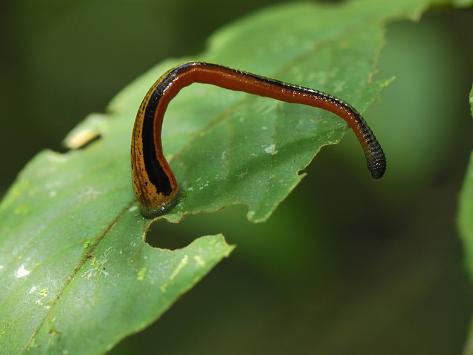


The sucker is critical for attaching to and remaining on a host. Principal among these is the muscular caudal sucker made up of the last seven somites of the segmented body. Though not all are sanguivorous, many leeches have special adaptations for blood feeding. They have a body consisting of 34 body segments (somites) but lack the chaetae (stiff hairs or bristles) of other annelids. These animals are simultaneous hermaphrodites. Leeches have a clitellum, or specialized saddle-shaped glandular segment, that secretes cocoons or egg cases. In addition, there are several predatory arhynchobdellids like the slender Erpobdelliformes (families Erpobdellidae, Salifidae, and Americobdellidae) the larger amphibious Haemopidae and several other poorly studied families. These leeches also have well-developed sensory systems for detecting vibrations, carbon dioxide, and heat. Terrestrial leeches have the additional adaptation of respiratory auricles near their caudal sucker that permit gas exchange without excessive loss of fluid. Both of these groups are equipped with a parabolic arc of 10 eyespots that detect movement in three dimensions. The jungle leeches are more common in the humid forests of Southern Asia, India, Madagascar, Australia, and Indonesia than their aquatic cousins. The blood-feeding arhynchobdellids include the large aquatic Hirudinidae (medicinal leeches) and the smaller terrestrial Haemadipsidae (jungle leeches). The Glossiphoniidae tend to be strongly dorsoventrally flattened freshwater species typically preferring anuran (frogs and toads) or chelonian (turtles and tortoises) hosts, though a few are specific to fishes and others will feed on mammals. The Piscicolidae family comprises small elongate, mostly marine species that feed seasonally on fishes. The two principal families of proboscis-bearing Rhynchobdellida have pairs of medial cephalic eyespots that can detect two-dimensional movement. The large worm-like Arhynchobdellida, of which Hirudo medicinalis is typical, have three muscular jaws, each of which may be armed with a row of teeth creating a serrated cutting edge.
#Tiger leech skin#
The Rhynchobdellida, as their name implies, have a muscular proboscis that allows them to feed on blood drawn from tissues beneath an organism's skin that are well supplied by blood vessels. Leeches are subdivided first into suborders based on anatomical adaptations for feeding. Taken together, these analyses demonstrate beyond question that leeches, branchiobdellidans (crayfish worms) and acanthobdellidans form a monophyletic (descended from a common taxon) group of oligochaetes that is closely related to the lumbriculid oligochaetes, or earthworms. The phylogenetic relationships of leeches have been the subject of several analyses based on morphological (structural) characters and DNA sequence data. This finding suggests that leeches are no older than vertebrates and probably no older than amphibians. The evolutionary relationships of leeches demonstrate that the ancestral hirudinid was a blood feeder in a freshwater environment.

Although there are two putative fossils from Bavarian deposits dating from the Upper Jurassic period (about 145 million years ago), Epitrachys rugosus (Ehlers, 1869) and Palaeohirudo eichstaettensis (Kozur, 1970), neither has both the definitive caudal sucker and the ring-shaped subdivisions of the body that would define them as leeches. Leeches are completely soft-bodied animals and could not be expected to leave a marked fossil record. Annelids possessing a caudal sucker used for attachment to surfaces, and a fixed number of body segments with subdivided annuli (ring-like structures) best known for their blood-sucking members and their use in medicine


 0 kommentar(er)
0 kommentar(er)
